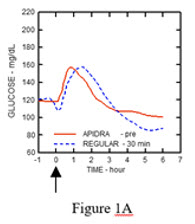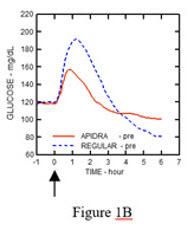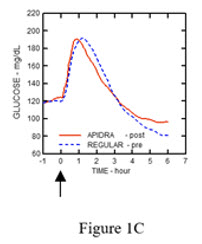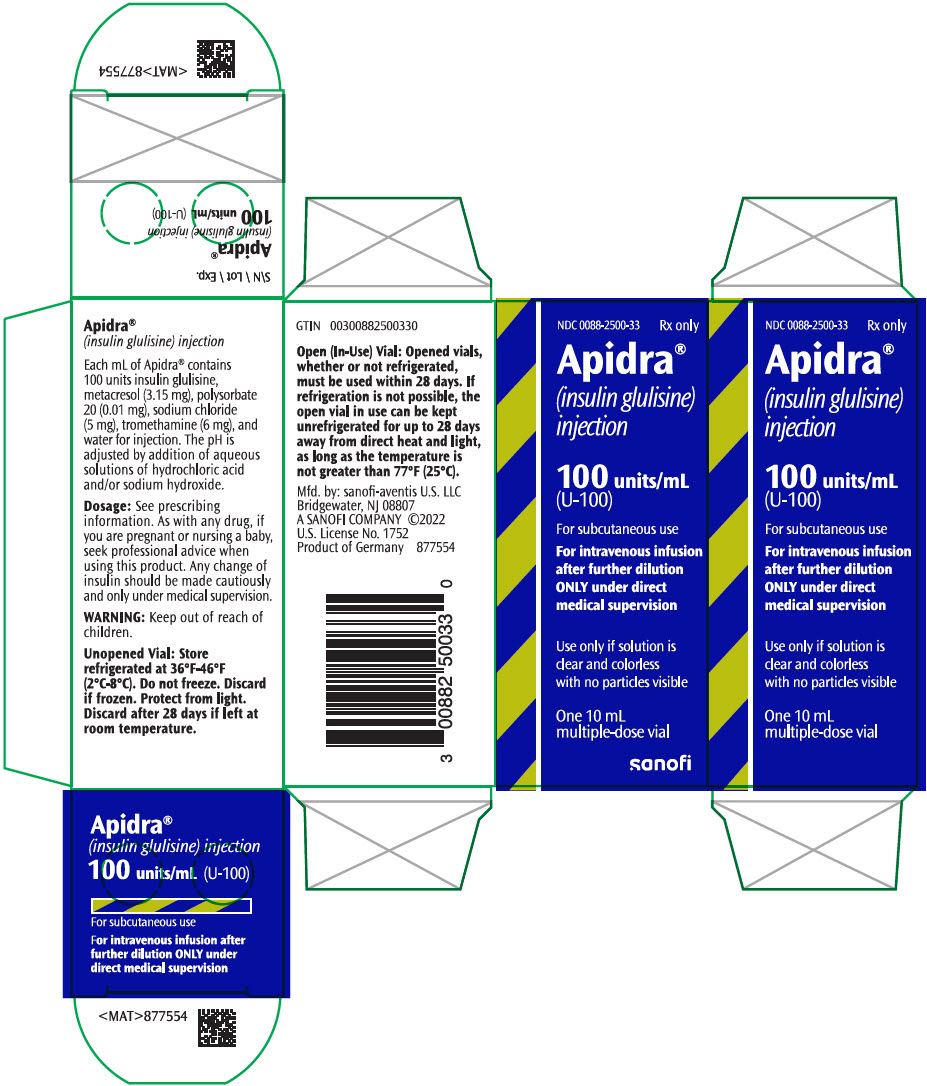Label: APIDRA- insulin glulisine injection, solution
APIDRA SOLOSTAR- insulin glulisine injection, solution
-
NDC Code(s):
0088-2500-33,
0088-2500-34,
0088-2502-00,
0088-2502-01, view more0088-2502-05
- Packager: sanofi-aventis U.S. LLC
- Category: HUMAN PRESCRIPTION DRUG LABEL
- DEA Schedule: None
- Marketing Status: Biologic Licensing Application
Drug Label Information
Updated July 25, 2023
If you are a consumer or patient please visit this version.
- Download DRUG LABEL INFO: PDF XML
- Official Label (Printer Friendly)
-
HIGHLIGHTS OF PRESCRIBING INFORMATION
These highlights do not include all the information needed to use APIDRA safely and effectively. See full prescribing information for APIDRA.
APIDRA® (insulin glulisine) injection, for subcutaneous or intravenous use
Initial U.S. Approval: 2004INDICATIONS AND USAGE
APIDRA is a rapid-acting human insulin analog indicated to improve glycemic control in adult and pediatric patients with diabetes mellitus. (1)
DOSAGE AND ADMINISTRATION
- See Full Prescribing Information for important administration instructions. (2.1, 2.2)
- Individualize and adjust the dosage of APIDRA based on route of administration, individual's metabolic needs, blood glucose monitoring results, and glycemic control goal. (2.3)
- Dosage adjustments may be needed when switching from another insulin, with changes in physical activity, changes in concomitant medications, changes in meal patterns, changes in renal or hepatic function or during acute illness. (2.3)
-
Subcutaneous Injection: (2.2)
- Inject within 15 minutes before a meal or within 20 minutes after starting a meal into the abdomen, thigh, or upper arm.
- Rotate injection sites within the same region to reduce the risk of lipodystrophy and localized cutaneous amyloidosis.
- Should generally be used in regimens with an intermediate or long-acting insulin.
-
Continuous Subcutaneous Infusion (Insulin Pump): (2.2)
- Refer to the insulin infusion pump user manual to see if APIDRA can be used. Use in accordance with the insulin pump instructions for use.
- Administer by continuous subcutaneous infusion using an insulin pump in a region recommended in the instructions from the pump manufacturer.
- Rotate infusion sites within the same region to reduce the risk of lipodystrophy and localized cutaneous amyloidosis.
- Do not mix with other insulins or diluents in the pump.
- Intravenous Administration: Administer only under medical supervision after diluting to concentrations from 0.05 to 1 unit/mL APIDRA in 0.9% sodium chloride injection, USP using polyvinyl chloride infusion bags. (2.2)
DOSAGE FORMS AND STRENGTHS
Injection 100 units/mL (U-100) is available as: (3)
- 10 mL multiple-dose vial
- 3 mL single-patient-use SoloStar® prefilled pen
CONTRAINDICATIONS
WARNINGS AND PRECAUTIONS
- Never share an APIDRA SoloStar pen between patients, even if the needle is changed. (5.1)
- Hyperglycemia or Hypoglycemia with Changes in Insulin Regimen: Make changes to a patient's insulin regimen (e.g., insulin strength, manufacturer, type, injection site or method of administration) under close medical supervision with increased frequency of blood glucose monitoring. (5.2)
- Hypoglycemia: May be life-threatening. Increase frequency of glucose monitoring with changes to: insulin dosage, coadministered glucose lowering medications, meal pattern, physical activity; and in patients with renal impairment or hepatic impairment or hypoglycemia unawareness. (5.3)
- Hypoglycemia Due to Medication Errors: Accidental mix-ups between insulin products can occur. Instruct patients to check insulin labels before injection. (5.4)
- Hypokalemia: May be life-threatening. Monitor potassium levels in patients at risk for hypokalemia and treat if indicated. (5.5)
- Hypersensitivity Reactions: Severe, life-threatening, generalized allergy, including anaphylaxis, can occur. Discontinue APIDRA, monitor and treat if indicated. (5.6)
- Fluid Retention and Heart Failure Can Occur with Concomitant Use of Thiazolidinediones (TZDs): Observe for signs and symptoms of heart failure; consider dosage reduction or discontinuation of TZD if heart failure occurs. (5.7)
- Hyperglycemia and Ketoacidosis Due to Insulin Pump Device Malfunction: Monitor glucose and administer APIDRA by subcutaneous injection if pump malfunction occurs. (5.8)
ADVERSE REACTIONS
Adverse reactions commonly associated with APIDRA include hypoglycemia, allergic reactions, injection site reactions, lipodystrophy, pruritus, rash, and weight gain. (6.1)
To report SUSPECTED ADVERSE REACTIONS, contact sanofi-aventis at 1-800-633-1610 or FDA at 1-800-FDA-1088 or www.fda.gov/medwatch.
DRUG INTERACTIONS
See 17 for PATIENT COUNSELING INFORMATION and FDA-approved patient labeling.
Revised: 11/2022
-
Table of Contents
FULL PRESCRIBING INFORMATION: CONTENTS*
1 INDICATIONS AND USAGE
2 DOSAGE AND ADMINISTRATION
2.1 Important Administration Instructions
2.2 Route of Administration Instructions
2.3 Dosage Information
3 DOSAGE FORMS AND STRENGTHS
4 CONTRAINDICATIONS
5 WARNINGS AND PRECAUTIONS
5.1 Never Share an APIDRA SoloStar Pen or Syringe or Needle between Patients
5.2 Hyperglycemia or Hypoglycemia with Changes in Insulin Regimen
5.3 Hypoglycemia
5.4 Hypoglycemia Due to Medication Errors
5.5 Hypokalemia
5.6 Hypersensitivity Reactions
5.7 Fluid Retention and Heart Failure with Concomitant Use of PPAR-Gamma Agonists
5.8 Hyperglycemia and Ketoacidosis Due to Insulin Pump Device Malfunction
6 ADVERSE REACTIONS
6.1 Clinical Trials Experience
6.2 Immunogenicity
6.3 Postmarketing Experience
7 DRUG INTERACTIONS
8 USE IN SPECIFIC POPULATIONS
8.1 Pregnancy
8.2 Lactation
8.4 Pediatric Use
8.5 Geriatric Use
8.6 Renal Impairment
8.7 Hepatic Impairment
10 OVERDOSAGE
11 DESCRIPTION
12 CLINICAL PHARMACOLOGY
12.1 Mechanism of Action
12.2 Pharmacodynamics
12.3 Pharmacokinetics
13 NONCLINICAL TOXICOLOGY
13.1 Carcinogenesis, Mutagenesis, Impairment of Fertility
14 CLINICAL STUDIES
14.1 Type 1 Diabetes-Adults
14.2 Type 2 Diabetes-Adults
14.3 Type 1 Diabetes-Adults: Pre and Postmeal Administration
14.4 Type 1 Diabetes-Pediatric Patients
14.5 Type 1 Diabetes-Adults: Continuous Subcutaneous Insulin Infusion
16 HOW SUPPLIED/STORAGE AND HANDLING
16.1 How Supplied
16.2 Storage
17 PATIENT COUNSELING INFORMATION
- *
- Sections or subsections omitted from the full prescribing information are not listed.
- 1 INDICATIONS AND USAGE
-
2 DOSAGE AND ADMINISTRATION
2.1 Important Administration Instructions
- Always check insulin label before administration [see Warnings and Precautions (5.4)].
- Inspect visually for particulate matter and discoloration. Only use APIDRA if the solution appears clear and colorless.
- Use APIDRA SoloStar prefilled pen with caution in patients with visual impairment who may rely on audible clicks to dial their dose.
2.2 Route of Administration Instructions
Subcutaneous Injection
- Inject APIDRA subcutaneously within 15 minutes before a meal or within 20 minutes after starting a meal into the abdominal wall, thigh, or upper arm.
- Rotate injection sites within the same region from one injection to the next to reduce the risk of lipodystrophy and localized cutaneous amyloidosis. Do not inject into areas of lipodystrophy or localized cutaneous amyloidosis [see Warnings and Precautions (5.2), Adverse Reactions (6)].
- APIDRA given by subcutaneous injection should generally be used in regimens with an intermediate or long-acting insulin.
- The APIDRA SoloStar prefilled pen dials in 1-unit increments.
- Do not mix APIDRA for subcutaneous injection with insulins other than NPH insulin. If APIDRA is mixed with NPH insulin, draw APIDRA into the syringe first and inject immediately after mixing.
Continuous Subcutaneous Infusion (Insulin Pump)
- Refer to the continuous subcutaneous insulin infusion pump user manual to see if APIDRA can be used with the insulin pump. Use APIDRA in accordance with the insulin pump system's instructions for use.
- Administer APIDRA by continuous subcutaneous infusion in a region recommended in the instructions from the pump manufacturer. Rotate infusion sites within the same region to reduce the risk of lipodystrophy and localized cutaneous amyloidosis. [see Warnings and Precautions (5.2), Adverse Reactions (6)].
- Train patients using continuous subcutaneous insulin infusion pump therapy to administer insulin by injection and have alternate insulin therapy available in case of insulin pump failure [see Warnings and Precautions (5.8)].
- During changes to a patient's insulin regimen, increase the frequency of blood glucose monitoring [see Warnings and Precautions (5.2)].
- Change APIDRA in the reservoir at least every 48 hours or according to the pump user manual, whichever is shorter.
- Change the infusion sets and the infusion set insertion site according to the manufacturer's user manual.
- Do not dilute or mix APIDRA when administering by continuous subcutaneous infusion.
- Do not expose APIDRA in the pump reservoir to temperatures greater than 98.6°F (37°C).
Intravenous Administration
- Administer APIDRA intravenously only under medical supervision with close monitoring of blood glucose and potassium levels to avoid hypoglycemia and hypokalemia [see Warnings and Precautions (5.3, 5.5)].
- Dilute APIDRA to concentrations from 0.05 unit/mL to 1 unit/mL insulin glulisine in infusion systems using polyvinyl chloride (PVC) infusion bags.
- Diluted APIDRA is stable at room temperature for 48 hours only in normal saline solution (0.9% Sodium Chloride Injection, USP) [see How Supplied/Storage and Handling (16.2)].
- APIDRA is not compatible with Dextrose solution and Ringers solution.
2.3 Dosage Information
- Individualize and adjust the dosage of APIDRA based on the patient's metabolic needs, blood glucose monitoring results, and glycemic control goal.
- Dose adjustments may be needed when switching from another insulin, with changes in physical activity, changes in concomitant medications, changes in meal patterns (i.e., macronutrient content or timing of food intake), changes in renal or hepatic function, or during acute illness to minimize the risk of hypoglycemia or hyperglycemia [see Warnings and Precautions (5.2, 5.3), Drug Interactions (7), Use in Specific Populations (8.6, 8.7)].
- 3 DOSAGE FORMS AND STRENGTHS
-
4 CONTRAINDICATIONS
APIDRA is contraindicated:
- during episodes of hypoglycemia
- in patients with known hypersensitivity to insulin glulisine or to any of the excipients in APIDRA; systemic allergic reactions have occurred with APIDRA [see Adverse Reactions (6.1)].
-
5 WARNINGS AND PRECAUTIONS
5.1 Never Share an APIDRA SoloStar Pen or Syringe or Needle between Patients
APIDRA SoloStar pens must never be shared between patients, even if the needle is changed. Patients using APIDRA vials must never reuse or share needles or syringes with another person. Sharing poses a risk for transmission of blood-borne pathogens.
5.2 Hyperglycemia or Hypoglycemia with Changes in Insulin Regimen
Changes in an insulin regimen (e.g., insulin, insulin strength, manufacturer, type, injection site or method of administration) may affect glycemic control and predispose to hypoglycemia [see Warnings and Precautions (5.3)] or hyperglycemia. Repeated insulin injections into areas of lipodystrophy or localized cutaneous amyloidosis have been reported to result in hyperglycemia; a sudden change in the injection site (to unaffected area) has been reported to result in hypoglycemia [see Adverse Reactions (6)].
Make any changes to a patient's insulin regimen under close medical supervision with increased frequency of blood glucose monitoring. Advise patients who have repeatedly injected into areas of lipodystrophy or localized cutaneous amyloidosis to change the injection site to unaffected areas and closely monitor for hypoglycemia. For patients with type 2 diabetes, dosage adjustments in concomitant oral antidiabetic treatment may be needed.
5.3 Hypoglycemia
Hypoglycemia is the most common adverse reaction of all insulins, including APIDRA [see Adverse Reactions (6.1)]. Severe hypoglycemia can cause seizures, may lead to unconsciousness, may be life-threatening, or cause death. Hypoglycemia can impair concentration ability and reaction time; this may place the patient and others at risk in situations where these abilities are important (e.g., driving or operating other machinery). APIDRA, or any insulin, should not be used during episodes of hypoglycemia [see Contraindications (4)].
Hypoglycemia can happen suddenly, and symptoms may differ in each patient and change over time in the same patient. Symptomatic awareness of hypoglycemia may be less pronounced in patients with longstanding diabetes, in patients with diabetic neuropathy, in patients using medications that block the sympathetic nervous system (e.g., beta-blockers) [see Drug Interactions (7)], or in patients who experience recurrent hypoglycemia.
Risk Factors for Hypoglycemia
The risk of hypoglycemia after an injection is related to the duration of action of the insulin and, in general, is highest when the glucose lowering effect of the insulin is maximal. The timing of hypoglycemia usually reflects the time-action profile of the administered insulin formulation. As with all insulins, the glucose lowering effect time course of APIDRA may vary in different individuals or at different times in the same individual and depends on many conditions, including the area of injection as well as the injection site blood supply and temperature [see Clinical Pharmacology (12.2)].
Other factors which may increase the risk of hypoglycemia include changes in meal pattern (e.g., macronutrient content or timing of meals), changes in level of physical activity, or changes to concomitant drugs [see Drug Interactions (7)]. Patients with renal or hepatic impairment may be at higher risk of hypoglycemia [see Use in Specific Populations (8.6, 8.7)].
Risk Mitigation Strategies for Hypoglycemia
Patients and caregivers must be educated to recognize and manage hypoglycemia. Self-monitoring of blood glucose plays an essential role in the prevention and management of hypoglycemia. In patients at higher risk for hypoglycemia and patients who have reduced symptomatic awareness of hypoglycemia, increased frequency of blood glucose monitoring is recommended.
5.4 Hypoglycemia Due to Medication Errors
Accidental mix-ups between insulin products have been reported. To avoid medication errors between APIDRA and other insulins, instruct patients to always check the insulin label before each injection [see Adverse Reactions (6.3)].
5.5 Hypokalemia
All insulins, including APIDRA, cause a shift in potassium from the extracellular to intracellular space, possibly leading to hypokalemia. Untreated hypokalemia may cause respiratory paralysis, ventricular arrhythmia, and death. Use caution in patients who may be at risk for hypokalemia (e.g., patients using potassium-lowering medications, patients taking medications sensitive to serum potassium concentrations).
5.6 Hypersensitivity Reactions
Severe, life-threatening, generalized allergy, including anaphylaxis, can occur with insulins, including APIDRA [see Adverse Reactions (6.1)]. If hypersensitivity reactions occur, discontinue APIDRA; treat per standard of care and monitor until symptoms and signs resolve. APIDRA is contraindicated in patients who have had a hypersensitivity reaction to insulin glulisine or any of its excipients.
5.7 Fluid Retention and Heart Failure with Concomitant Use of PPAR-Gamma Agonists
Thiazolidinediones (TZDs), which are peroxisome proliferator-activated receptor (PPAR) gamma agonists, can cause dose-related fluid retention, when used in combination with insulin. Fluid retention may lead to or exacerbate heart failure. Patients treated with insulin, including APIDRA and a PPAR-gamma agonist should be observed for signs and symptoms of heart failure. If heart failure develops, it should be managed according to current standards of care, and discontinuation or dose reduction of the PPAR-gamma agonist must be considered.
5.8 Hyperglycemia and Ketoacidosis Due to Insulin Pump Device Malfunction
Malfunction of the insulin pump or insulin infusion set or insulin degradation can rapidly lead to hyperglycemia and ketoacidosis. Prompt identification and correction of the cause of hyperglycemia or ketosis is necessary. Interim subcutaneous injections with APIDRA may be required. Patients using continuous subcutaneous insulin infusion pump therapy must be trained to administer insulin by injection and have alternate insulin therapy available in case of pump failure [see How Supplied/Storage and Handling (16.2)].
-
6 ADVERSE REACTIONS
The following adverse reactions are discussed elsewhere:
- Hypoglycemia [see Warnings and Precautions (5.3)]
- Hypoglycemia Due to Medication Errors [see Warnings and Precautions (5.4)]
- Hypokalemia [see Warnings and Precautions (5.5)]
- Hypersensitivity Reactions [see Warnings and Precautions (5.6)]
6.1 Clinical Trials Experience
Because clinical trials are conducted under widely varying designs, the adverse reaction rates reported in one clinical trial may not be easily compared to those rates reported in another clinical trial and may not reflect the rates actually observed in clinical practice.
The data in Table 1 reflect the exposure of 1591 patients with type 1 diabetes to APIDRA or comparators [see Clinical Studies (14.1)]. The type 1 diabetes population had the following characteristics: Mean age was 39.74 years. 54.5 % were male, 95.5% were Caucasian, 1.5% were Black or African American.
The data in Table 2 reflect the exposure of 1766 patients with type 2 diabetes to APIDRA or comparators [see Clinical Studies (14.2)]. The type 2 diabetes population had the following characteristics: Mean age was 59.08 years. 51.2% were male, 88.5% were Caucasian, 7.2% were Black or African American.
The frequencies of adverse drug reactions during APIDRA clinical trials in patients with type 1 diabetes mellitus and type 2 diabetes mellitus are listed in the tables below.
Table 1: Adverse Reactions Occurring ≥5% in Pooled Studies of Adults with Type 1 Diabetes APIDRA, %
(n=950)All Comparators*, %
(n=641)Nasopharyngitis 10.6 12.9 Hypoglycemia† 6.8 6.7 Upper respiratory tract infection 6.6 5.6 Influenza 4.0 5.0 Table 2: Adverse Reactions Occurring ≥5% in Pooled Studies of Adults with Type 2 Diabetes APIDRA, %
(n=883)Regular Human Insulin, %
(n=883)Upper respiratory tract infection 10.5 7.7 Nasopharyngitis 7.6 8.2 Edema peripheral 7.5 7.8 Influenza 6.2 4.2 Arthralgia 5.9 6.3 Hypertension 3.9 5.3 Pediatrics
Table 3 summarizes the adverse reactions occurring with frequency higher than 5% in a clinical study in pediatric patients with type 1 diabetes treated with APIDRA (n=277) or insulin lispro (n=295).
Table 3: Adverse Reactions Occurring ≥5% in Pediatric Patients with Type 1 Diabetes APIDRA, %
(n=277)Insulin Lispro, %
(n=295)Nasopharyngitis 9.0 9.5 Upper respiratory tract infection 8.3 10.8 Headache 6.9 11.2 Hypoglycemic seizure 6.1 4.7 Severe Symptomatic Hypoglycemia
Hypoglycemia was the most commonly observed adverse reaction in patients treated with insulin, including APIDRA. The rates of reported hypoglycemia depend on the definition of hypoglycemia used, diabetes type, insulin dose, intensity of glucose control, background therapies, and other intrinsic and extrinsic patient factors. For these reasons, comparing rates of hypoglycemia in clinical trials for APIDRA with the incidence of hypoglycemia for other products may be misleading and also, may not be representative of hypoglycemia rates that occur in clinical practice. The rates and incidence of severe symptomatic hypoglycemia, defined as hypoglycemia requiring intervention from a third party are presented in Table 4. In the clinical trials, children and adolescents with type 1 diabetes had a higher incidence of severe symptomatic hypoglycemia in the two treatment groups compared to adults with type 1 diabetes (see Table 4) [see Clinical Studies (14)].
Table 4: Severe Symptomatic Hypoglycemia* Type 1 Diabetes
Adults
12 weeks with insulin glargineType 1 Diabetes
Adults
26 weeks with insulin glargineType 2 Diabetes
Adults
26 weeks with NPH human insulinType 1 Diabetes
Pediatrics
26 weeks- *
- Severe symptomatic hypoglycemia defined as a hypoglycemic event requiring the assistance of another person that met one of the following criteria:
the event was associated with a whole blood referenced blood glucose <36 mg/dL or the event was associated with prompt recovery after oral carbohydrate, intravenous glucose, or glucagon administration.
APIDRA
Pre mealAPIDRA
Post mealRegular Human Insulin APIDRA Insulin Lispro APIDRA Regular Human Insulin APIDRA Insulin Lispro Events per month per patient 0.05 0.05 0.13 0.02 0.02 0.00 0.00 0.09 0.08 Percent of patients
(n/total N)8.4%
(24/286)8.4%
(25/296)10.1%
(28/278)4.8%
(16/339)4.0%
(13/333)1.4%
(6/416)1.2%
(5/420)16.2%
(45/277)19.3%
(57/295)Adverse Reactions with Continuous Subcutaneous Insulin Infusion (CSII)
In a 12-week randomized study in patients with type 1 diabetes (n=59), the rates of catheter occlusions and infusion site reactions were similar for APIDRA and insulin aspart–treated patients (see Table 5).
Table 5: Catheter Occlusions and Infusion Site Reactions APIDRA
(n=29)Insulin Aspart
(n=30)Catheter occlusions/month 0.08 0.15 Infusion site reactions 10.3% (3/29) 13.3% (4/30) Allergic Reactions
Severe, life-threatening, generalized allergy, including anaphylaxis, may occur with any insulin, including APIDRA. Generalized allergy to insulin may cause whole body rash (including pruritus), dyspnea, wheezing, hypotension, tachycardia, or diaphoresis.
In controlled clinical trials up to 12 months duration, potential systemic allergic reactions were reported in 79 of 1833 patients (4.3%) who received APIDRA and 58 of 1524 patients (3.8%) who received the comparator short-acting insulins. During these trials, treatment with APIDRA was permanently discontinued in 1 of 1833 patients due to a potential systemic allergic reaction.
Injection Site Reactions
As with any insulin, patients taking APIDRA may experience redness, swelling, or itching at the site of injection. These minor reactions usually resolve in a few days to a few weeks, but on some occasions may require discontinuation of APIDRA. In some instances, these reactions may be related to factors other than insulin, such as irritants in a skin cleansing agent or poor injection technique.
Insulin Initiation and Intensification of Glucose Control
Intensification or rapid improvement in glucose control has been associated with a transitory, reversible ophthalmologic refraction disorder, worsening of diabetic retinopathy, and acute painful peripheral neuropathy. However, long-term glycemic control decreases the risk of diabetic retinopathy and neuropathy.
Lipodystrophy
Long-term use of insulin, including APIDRA, can cause lipodystrophy at the site of repeated insulin injections or infusion. Lipodystrophy includes lipohypertrophy (thickening of adipose tissue) and lipoatrophy (thinning of adipose tissue) and may affect insulin absorption [see Dosage and Administration (2.2)].
6.2 Immunogenicity
As with all therapeutic proteins, there is potential for immunogenicity. The detection of antibody formation is highly dependent on the sensitivity and specificity of the assay. Additionally, the observed incidence of antibody (including neutralizing antibody) positivity in an assay may be influenced by several factors including assay methodology, sample handling, timing of sample collection, concomitant medication, and underlying disease. For these reasons, comparison of the incidence of antibodies to APIDRA in the studies described below with the incidence of antibodies in other studies or to other insulin products may be misleading.
In a study in patients with type 1 diabetes (n=333), the concentrations of insulin antibodies that react with both human insulin and insulin glulisine (cross-reactive insulin antibodies) remained near baseline during the first 6 months of the study in the patients treated with APIDRA. A decrease in antibody concentration was observed during the following 6 months of the study. In a study in patients with type 2 diabetes (n=411), a similar increase in cross-reactive insulin antibody concentration was observed in the patients treated with APIDRA and in the patients treated with human insulin during the first 9 months of the study. Thereafter the concentration of antibodies decreased in the APIDRA patients and remained stable in the human insulin patients. There was no correlation between cross-reactive insulin antibody concentration and changes in HbA1c, insulin doses, or incidence of hypoglycemia. APIDRA did not elicit a significant antibody response in a study of pediatric patients with type 1 diabetes.
6.3 Postmarketing Experience
The following adverse reactions have been identified during postapproval use of APIDRA. Because these reactions are reported voluntarily from a population of uncertain size, it is not always possible to estimate reliably their frequency or establish a causal relationship to drug exposure.
Medication errors have been reported in which other insulins, particularly long-acting insulins, have been accidentally administered instead of APIDRA.
Localized cutaneous amyloidosis at the injection site has occurred. Hyperglycemia has been reported with repeated insulin injections into areas of localized cutaneous amyloidosis; hypoglycemia has been reported with a sudden change to an unaffected injection site.
-
7 DRUG INTERACTIONS
Table 6: Clinically Significant Drug Interactions with APIDRA Drugs that May Increase the Risk of Hypoglycemia Drugs: Antidiabetic agents, ACE inhibitors, angiotensin II receptor blocking agents, disopyramide, fibrates, fluoxetine, monoamine oxidase inhibitors, pentoxifylline, pramlintide, salicylates, somatostatin analog (e.g., octreotide), and sulfonamide antibiotics. Intervention: Dose adjustment and increased frequency of glucose monitoring may be required when APIDRA is coadministered with these drugs. Drugs that May Decrease the Blood Glucose Lowering Effect of APIDRA Drugs: Atypical antipsychotics, corticosteroids, danazol, diuretics, estrogens, glucagon, isoniazid, niacin, phenothiazine derivatives, progestogens (e.g., in oral contraceptives), protease inhibitors, somatropin, sympathomimetic agents (e.g., albuterol, epinephrine, terbutaline), and thyroid hormones. Intervention: Dose adjustment and increased frequency of glucose monitoring may be required when APIDRA is coadministered with these drugs. Drugs that May Increase or Decrease the Blood Glucose Lowering Effect of APIDRA Drugs: Alcohol, beta-blockers, clonidine, and lithium salts. Pentamidine may cause hypoglycemia, which may sometimes be followed by hyperglycemia. Intervention: Dose adjustment and increased frequency of glucose monitoring may be required when APIDRA is coadministered with these drugs. Drugs that May Blunt Signs and Symptoms of Hypoglycemia Drugs: Beta-blockers, clonidine, guanethidine, and reserpine. Intervention: Increased frequency of glucose monitoring may be required when APIDRA is coadministered with these drugs. -
8 USE IN SPECIFIC POPULATIONS
8.1 Pregnancy
Risk Summary
Available pharmacovigilance data have not established an association with insulin glulisine use during pregnancy and major birth defects, miscarriage or adverse maternal or fetal outcomes. There are risks to the mother and fetus associated with poorly controlled diabetes in pregnancy (see Clinical Considerations). Animal reproduction studies have been conducted with insulin glulisine in rats and rabbits using regular human insulin as a comparator. Insulin glulisine was given to female rats throughout pregnancy at subcutaneous doses up to 10 units/kg/day (2 times the average human dose, based on body surface area comparison) and to rabbits during organogenesis at subcutaneous doses up to 1.5 units/kg/day (0.5 times the average human dose, based on body surface area comparison). The effects did not differ from those observed with subcutaneous regular human insulin (see Data).
In the U.S. general population, the estimated background risk of major birth defects and miscarriage in clinically recognized pregnancies is 2% to 4% and 15% to 20%, respectively. The estimated background risk of major birth defects is 6% to 10% in women with pre-gestational diabetes with a peri-conceptional HbA1c >7 and has been reported to be as high as 20% to 25% in women with a peri-conceptional HbA1c >10. The estimated background risk of miscarriage for the indicated population is unknown.
Clinical Considerations
Disease-associated maternal and/or embryo-fetal risk
Hypoglycemia and hyperglycemia occur more frequently during pregnancy in patients with pre-gestational diabetes. Poorly controlled diabetes in pregnancy increases the maternal risk for diabetic ketoacidosis, pre-eclampsia, spontaneous abortions, preterm delivery, and delivery complications. Poorly controlled diabetes increases the fetal risk for major birth defects, still birth, and macrosomia-related morbidity.
Data
Animal data
Insulin glulisine was given to pregnant female rabbits during gestation at doses up to 1.5 units/kg/day, resulting in an exposure 0.5 times the average human dose, based on body surface area. Adverse effects on embryo-fetal development, including postimplantation loss and skeletal defects, were observed at dose levels that caused maternal hypoglycemia and mortality.
Insulin glulisine given to pregnant female rats during gestation at doses up to 10 units/kg/day, resulting in an exposure 2 times the average human dose based on body surface area, resulted in maternal toxicity indicative of hypoglycemia but did not adversely affect embryo-fetal development. Postnatal development was not adversely affected following administration of insulin glulisine to pregnant female rats during gestation and throughout lactation at doses up to 8 units/kg/day.
The effects of insulin glulisine did not differ from those observed with regular human insulin used as a comparator in the same studies and administered at the same doses.
8.2 Lactation
Risk Summary
Available data from published literature suggest that human insulin products, including APIDRA, are transferred into human milk. There are no adverse reactions reported in the breastfed infants in the literature. There are no data on the effects of exogenous human insulin products, including APIDRA, on milk production. The developmental and health benefits of breastfeeding should be considered along with the mother's clinical need for APIDRA and any potential adverse effects on the breastfed infant from APIDRA or from the underlying maternal condition.
8.4 Pediatric Use
The safety and effectiveness of APIDRA to improve glycemic control have been established in pediatric patients. Use of APIDRA for this indication is supported by evidence from an active-controlled non-inferiority study in pediatric patients 4 years of age and older with type 1 diabetes mellitus treated with APIDRA (n=271) and from studies in adults with diabetes mellitus [see Clinical Pharmacology (12.3), and Clinical Studies (14)].
In the clinical trials, pediatric patients with type 1 diabetes mellitus had a higher incidence of severe symptomatic hypoglycemia in the two treatment groups compared to adults with type 1 diabetes mellitus [see Adverse Reactions (6.1)].
8.5 Geriatric Use
In clinical trials, APIDRA was administered to 147 patients ≥65 years of age and 27 patients ≥75 years of age. The majority of this small subset of geriatric patients had type 2 diabetes. The change in HbA1c values and hypoglycemia frequencies did not differ by age.
Nevertheless, caution should be exercised when APIDRA is administered to geriatric patients. In geriatric patients with diabetes, the initial dosing, dose increments, and maintenance dosage should be conservative to reduce the risk of hypoglycemia [see Warnings and Precautions (5.3)].
8.6 Renal Impairment
Patients with renal impairment may be at increased risk of hypoglycemia and may require more frequent APIDRA dose adjustment and more frequent blood glucose monitoring [see Warnings and Precautions (5.3) and Clinical Pharmacology (12.3)].
8.7 Hepatic Impairment
Patients with hepatic impairment may be at increased risk of hypoglycemia and may require more frequent APIDRA dose adjustment and more frequent blood glucose monitoring [see Warnings and Precautions (5.3) and Clinical Pharmacology (12.3)].
-
10 OVERDOSAGE
Excess insulin may cause hypoglycemia and, particularly when given intravenously, hypokalemia. Mild episodes of hypoglycemia usually can be treated with oral glucose. Adjustments in drug dosage, meal patterns, or exercise may be needed. More severe episodes of hypoglycemia with coma, seizure, or neurologic impairment may be treated with a glucagon product for emergency use or concentrated intravenous glucose. Sustained carbohydrate intake and observation may be necessary because hypoglycemia may recur after apparent clinical recovery. Hypokalemia must be corrected appropriately.
-
11 DESCRIPTION
Insulin glulisine is a rapid-acting human insulin analog used to lower blood glucose. Insulin glulisine is produced by recombinant DNA technology utilizing a non-pathogenic laboratory strain of Escherichia coli (K12). Insulin glulisine differs from human insulin in that the amino acid asparagine at position B3 is replaced by lysine and the lysine in position B29 is replaced by glutamic acid. Insulin glulisine has a molecular weight of 5.823 kDa.
APIDRA (insulin glulisine) injection is a sterile, aqueous, clear, and colorless solution for subcutaneous or intravenous use. Each milliliter of APIDRA contains 100 units insulin glulisine, metacresol (3.15 mg), polysorbate 20 (0.01 mg), sodium chloride (5 mg), tromethamine (6 mg), and water for injection. APIDRA has a pH of approximately 7.3. The pH is adjusted by addition of aqueous solutions of hydrochloric acid and/or sodium hydroxide.
-
12 CLINICAL PHARMACOLOGY
12.1 Mechanism of Action
Regulation of glucose metabolism is the primary activity of insulins and insulin analogs, including insulin glulisine. Insulins lower blood glucose by stimulating peripheral glucose uptake by skeletal muscle and fat, and by inhibiting hepatic glucose production. Insulins inhibit lipolysis and proteolysis and enhance protein synthesis.
12.2 Pharmacodynamics
Studies in healthy volunteers and patients with diabetes demonstrated that APIDRA has a more rapid onset of action and a shorter duration of activity than regular human insulin when given subcutaneously.
In a study in patients with type 1 diabetes (n=20), the glucose-lowering profiles of APIDRA and regular human insulin were assessed at various times in relation to a standard meal at a dose of 0.15 units/kg (see Figure 1).
The maximum blood glucose excursion (ΔGLUmax; baseline subtracted glucose concentration) for APIDRA injected 2 minutes before a meal was 65 mg/dL compared to 64 mg/dL for regular human insulin injected 30 minutes before a meal (see Figure 1A), and 84 mg/dL for regular human insulin injected 2 minutes before a meal (see Figure 1B). The maximum blood glucose excursion for APIDRA injected 15 minutes after the start of a meal was 85 mg/dL compared to 84 mg/dL for regular human insulin injected 2 minutes before a meal (see Figure 1C).
Figure 1: Serial mean blood glucose collected up to 6 hours following a single dose of APIDRA and regular human insulin. APIDRA given 2 minutes (APIDRA - pre) before the start of a meal compared to regular human insulin given 30 minutes (Regular - 30 min) before start of the meal (see Figure 1A) and compared to regular human insulin (Regular - pre) given 2 minutes before a meal (see Figure 1B). APIDRA given 15 minutes (APIDRA - post) after start of a meal compared to regular human insulin (Regular - pre) given 2 minutes before a meal (see Figure 1C). On the x-axis, zero (0) is the start of a 15-minute meal.
In a randomized, open-label, two-way crossover study, 16 healthy male subjects received an intravenous infusion of APIDRA or regular human insulin with saline diluent at a rate of 0.8 milliunits/kg/min for two hours. Infusion of the same dose of APIDRA or regular human insulin produced equivalent glucose disposal at steady state.
12.3 Pharmacokinetics
Absorption and Bioavailability
Pharmacokinetic profiles in healthy volunteers and patients with diabetes (type 1 or type 2) demonstrated that absorption of insulin glulisine was faster than that of regular human insulin.
In a study in patients with type 1 diabetes (n=20) after subcutaneous administration of 0.15 units/kg, the median time to maximum concentration (Tmax) was 60 minutes (range 40 to 120 minutes) and the peak concentration (Cmax) was 83 microunits/mL (range 40 to 131 microunits/mL) for insulin glulisine compared to a median Tmax of 120 minutes (range 60 to 239 minutes) and a Cmax of 50 microunits/mL (range 35 to 71 microunits/mL) for regular human insulin (see Figure 2).
Figure 2: Pharmacokinetic Profiles of Insulin Glulisine and Regular Human Insulin in Patients with Type 1 Diabetes after a Dose of 0.15 units/kg.
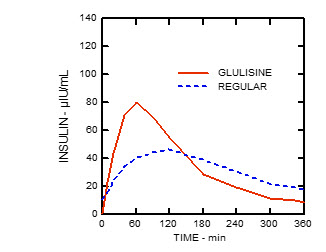
Insulin glulisine and regular human insulin were administered subcutaneously at a dose of 0.2 units/kg in a euglycemic clamp study in patients with type 2 diabetes (n=24) and a body mass index (BMI) between 20 and 36 kg/m2. The median time to maximum concentration (Tmax) was 100 minutes (range 40 to 120 minutes) and the median peak concentration (Cmax) was 84 microunits/mL (range 53 to 165 microunits/mL) for insulin glulisine compared to a median Tmax of 240 minutes (range 80 to 360 minutes) and a median Cmax of 41 microunits/mL (range 33 to 61 microunits/mL) for regular human insulin (see Figure 3).
Figure 3: Pharmacokinetic Profiles of Insulin Glulisine and Regular Human Insulin in Patients with Type 2 Diabetes after a Subcutaneous Dose of 0.2 units/kg.
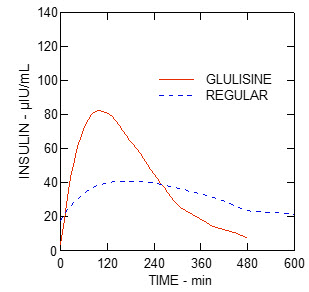
When APIDRA was injected subcutaneously into different areas of the body, the time-concentration profiles were similar. The absolute bioavailability of insulin glulisine after subcutaneous administration is approximately 70%, regardless of injection area (abdomen 73%, deltoid 71%, thigh 68%).
In a clinical study in healthy volunteers (n=32) the total insulin glulisine bioavailability was similar after subcutaneous injection of insulin glulisine and NPH insulin (premixed in the syringe) and following separate simultaneous subcutaneous injections. There was 27% attenuation of the maximum concentration (Cmax) of APIDRA after premixing; however, the time to maximum concentration (Tmax) was not affected.
Distribution and Elimination
The distribution and elimination of insulin glulisine and regular human insulin after intravenous administration are similar with volumes of distribution of 13 and 21 L and half-lives of 13 and 17 minutes, respectively. After subcutaneous administration, insulin glulisine is eliminated more rapidly than regular human insulin with an apparent half-life of 42 minutes compared to 86 minutes.
Specific Populations
Pediatric patients
The pharmacokinetic and pharmacodynamic properties of APIDRA and regular human insulin were assessed in a study conducted in pediatric patients 7 to 11 years old (n=10) and 12 to 16 years old (n=10) with type 1 diabetes. The relative differences in pharmacokinetics and pharmacodynamics between APIDRA and regular human insulin in these patients with type 1 diabetes were similar to those in healthy adult subjects and adults with type 1 diabetes.
Race
A study in 24 healthy Caucasians and Japanese subjects compared the pharmacokinetics and pharmacodynamics after subcutaneous injection of insulin glulisine, insulin lispro, and regular human insulin. With subcutaneous injection of insulin glulisine, Japanese subjects had a greater initial exposure (33%) for the ratio of AUC(0–1h) to AUC(0–clamp end) than Caucasians (21%) although the total exposures were similar. There were similar findings with insulin lispro and regular human insulin.
Obesity
Insulin glulisine and regular human insulin were administered subcutaneously at a dose of 0.3 units/kg in a euglycemic clamp study in obese, non-diabetic subjects (n=18) with a body mass index (BMI) between 30 and 40 kg/m2. The median time to maximum concentration (Tmax) was 85 minutes (range 49 to 150 minutes) and the median peak concentration (Cmax) was 192 microunits/mL (range 98 to 380 microunits/mL) for insulin glulisine compared to a median Tmax of 150 minutes (range 90 to 240 minutes) and a median Cmax of 86 microunits/mL (range 43 to 175 microunits/mL) for regular human insulin.
The more rapid onset of action and shorter duration of activity of APIDRA and insulin lispro compared to regular human insulin were maintained in an obese non-diabetic population (n=18) (see Figure 4).
Figure 4: Glucose Infusion Rates (GIR) in a Euglycemic Clamp Study after Subcutaneous Injection of 0.3 units/kg of APIDRA, Insulin Lispro or Regular Human Insulin in an Obese Population.
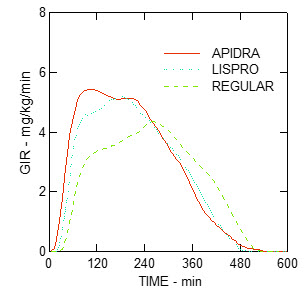
Renal impairment
Studies with human insulin have shown increased circulating levels of insulin in patients with renal failure. In a study performed in 24 non-diabetic subjects with normal renal function (ClCr >80 mL/min), moderate renal impairment (30–50 mL/min), and severe renal impairment (<30 mL/min), the subjects with moderate and severe renal impairment had increased exposure to insulin glulisine by 29% to 40% and reduced clearance of insulin glulisine by 20% to 25% compared to subjects with normal renal function [see Use in Specific Populations (8.6)].
Hepatic impairment
The effect of hepatic impairment on the pharmacokinetics and pharmacodynamics of APIDRA has not been studied. Some studies with human insulin have shown increased circulating levels of insulin in patients with liver failure [see Use in Specific Populations (8.7)].
-
13 NONCLINICAL TOXICOLOGY
13.1 Carcinogenesis, Mutagenesis, Impairment of Fertility
Long-term carcinogenicity studies in animals have not been performed. In Sprague Dawley rats, a 12-month study was conducted with insulin glulisine at subcutaneous doses of 2.5, 5, 20 or 50 units/kg administered twice daily, resulting in an exposure 1, 2, 8, and 20 times the average human dose, based on body surface area.
There was a non-dose dependent higher incidence of mammary gland tumors in female rats administered insulin glulisine compared to untreated controls. The incidence of mammary tumors for insulin glulisine and regular human insulin was similar. Insulin glulisine was not mutagenic in the following tests: Ames test, in vitro mammalian chromosome aberration test in V79 Chinese hamster cells, and in vivo mammalian erythrocyte micronucleus test in rats.
In fertility studies in male and female rats at subcutaneous doses up to 10 units/kg/day (2 times the average human dose, based on body surface area comparison), no clear adverse effects on male and female fertility, or general reproductive performance of animals were observed.
-
14 CLINICAL STUDIES
The safety and efficacy of APIDRA were studied in adult patients with type 1 and type 2 diabetes (n=1833) and in pediatric patients (4 to 17 years) with type 1 diabetes (n=572). The primary efficacy parameter in these trials was glycemic control, assessed using glycated hemoglobin (GHb reported as HbA1c equivalent).
14.1 Type 1 Diabetes-Adults
A 26-week, randomized, open-label, active-controlled, non-inferiority study was conducted in patients with type 1 diabetes to assess the safety and efficacy of APIDRA (n=339) compared to insulin lispro (n=333) when administered subcutaneously within 15 minutes before a meal. Insulin glargine was administered once daily in the evening as the basal insulin. There was a 4-week run-in period with insulin lispro and insulin glargine prior to randomization. Most patients were Caucasian (97%). Fifty-eight percent of the patients were men. The mean age was 39 years (range 18 to 74 years). Glycemic control, the number of daily short-acting insulin injections and the total daily doses of APIDRA and insulin lispro were similar in the two treatment groups (see Table 7).
Table 7: Type 1 Diabetes Mellitus–Adult Treatment duration
Treatment in combination with:26 weeks
Insulin glargineAPIDRA Insulin Lispro - *
- GHb reported as HbA1c equivalent
Glycated hemoglobin (GHb)* (%)
Number of patients
331
322Baseline mean 7.6 7.6 Adjusted mean change from baseline -0.1 -0.1 Treatment difference: APIDRA – Insulin Lispro 0.0 95% CI for treatment difference (-0.1; 0.1) Basal insulin dose (Units/day) Baseline mean 24 24 Adjusted mean change from baseline 0 2 Short-acting insulin dose (Units/day) Baseline mean 30 31 Adjusted mean change from baseline -1 -1 Mean number of short-acting insulin injections per day 3 3 Body weight (kg) Baseline mean 73.9 74.1 Mean change from baseline 0.6 0.3 14.2 Type 2 Diabetes-Adults
A 26-week, randomized, open-label, active-controlled, non-inferiority study was conducted in insulin-treated patients with type 2 diabetes to assess the safety and efficacy of APIDRA (n=435) given within 15 minutes before a meal compared to regular human insulin (n=441) administered 30 to 45 minutes prior to a meal. NPH human insulin was given twice a day as the basal insulin. All patients participated in a 4-week run-in period with regular human insulin and NPH human insulin. Eighty-five percent of patients were Caucasian and 11% were Black. The mean age was 58 years (range 26 to 84 years). The average body mass index (BMI) was 34.6 kg/m2. At randomization, 58% of the patients were taking an oral antidiabetic agent. These patients were instructed to continue use of their oral antidiabetic agent at the same dose throughout the trial. The majority of patients (79%) mixed their short-acting insulin with NPH human insulin immediately prior to injection. The reductions from baseline in GHb were similar between the 2 treatment groups (see Table 8). No differences between APIDRA and regular human insulin groups were seen in the number of daily short-acting insulin injections or basal or short-acting insulin doses (see Table 8).
Table 8: Type 2 Diabetes Mellitus–Adult Treatment duration
Treatment in combination with:26 weeks
NPH human insulinAPIDRA Regular Human Insulin - *
- GHb reported as HbA1c equivalent
Glycated hemoglobin (GHb)* (%)
Number of patients
404
403Baseline mean 7.6 7.5 Adjusted mean change from baseline -0.5 -0.3 Treatment difference: APIDRA – Regular Human Insulin -0.2 95% CI for treatment difference (-0.3; -0.1) Basal insulin dose (Units/day) Baseline mean 59 57 Adjusted mean change from baseline 6 6 Short-acting insulin dose (Units/day) Baseline mean 32 31 Adjusted mean change from baseline 4 5 Mean number of short-acting insulin injections per day 2 2 Body weight (kg) Baseline mean 100.5 99.2 Mean change from baseline 1.8 2.0 14.3 Type 1 Diabetes-Adults: Pre and Postmeal Administration
A 12-week, randomized, open-label, active-controlled, non-inferiority study was conducted in patients with type 1 diabetes to assess the safety and efficacy of APIDRA administered at different times with respect to a meal. APIDRA was administered subcutaneously either within 15 minutes before a meal (n=286) or immediately after a meal (n=296) and regular human insulin (n=278) was administered subcutaneously 30 to 45 minutes prior to a meal. Insulin glargine was administered once daily at bedtime as the basal insulin. There was a 4-week run-in period with regular human insulin and insulin glargine followed by randomization. Most patients were Caucasian (94%). The mean age was 40 years (range 18 to 73 years). Glycemic control (see Table 9) was comparable for the 3 treatment regimens. No changes from baseline between the treatments were seen in the total daily number of short-acting insulin injections (see Table 9).
Table 9: Pre and Postmeal Administration in Type 1 Diabetes Mellitus–Adult Treatment duration
Treatment in combination with:12 weeks
insulin glargine12 weeks
insulin glargine12 weeks
insulin glargineAPIDRA
pre mealAPIDRA
post mealRegular Human Insulin Glycated hemoglobin (GHb)* (%)
Number of patients
268
276
257Baseline mean 7.7 7.7 7.6 Adjusted mean change from baseline† -0.3 -0.1 -0.1 Basal insulin dose (Units/day) Baseline mean 29 29 28 Adjusted mean change from baseline 1 0 1 Short-acting insulin dose (Units/day) Baseline mean 29 29 27 Adjusted mean change from baseline -1 -1 2 Mean number of short-acting insulin injections per day 3 3 3 Body weight (kg) Baseline mean 79.2 80.3 78.9 Mean change from baseline 0.3 -0.3 0.3 14.4 Type 1 Diabetes-Pediatric Patients
A 26-week, randomized, open-label, active-controlled, non-inferiority study was conducted in children and adolescents older than 4 years of age with type 1 diabetes mellitus to assess the safety and efficacy of APIDRA (n=277) compared to insulin lispro (n=295) when administered subcutaneously within 15 minutes before a meal. Patients also received insulin glargine (administered once daily in the evening) or NPH insulin (administered once in the morning and once in the evening). There was a 4-week run-in period with insulin lispro and insulin glargine or NPH prior to randomization. Most patients were Caucasian (91%). Fifty percent of the patients were male. The mean age was 12.5 years (range 4 to 17 years). Mean BMI was 20.6 kg/m2. Glycemic control (see Table 10) was comparable for the two treatment regimens.
Table 10: Results from a 26-Week Study in Pediatric Patients with Type 1 Diabetes Mellitus APIDRA Insulin Lispro - *
- GHb reported as HbA1c equivalent
Number of patients 271 291 Basal Insulin NPH or insulin glargine NPH or insulin glargine Glycated hemoglobin (GHb)* (%) Baseline mean 8.2 8.2 Adjusted mean change from baseline 0.1 0.2 Treatment Difference: Mean (95% confidence interval) -0.1 (-0.2, 0.1) Basal insulin dose (Units/kg/day) Baseline mean 0.5 0.5 Mean change from baseline 0.0 0.0 Short-acting insulin dose (Units/kg/day) Baseline mean 0.5 0.5 Mean change from baseline 0.0 0.0 Mean number of short-acting insulin injections per day 3 3 Baseline mean body weight (kg)
Mean weight change from baseline (kg)51.5
2.250.8
2.214.5 Type 1 Diabetes-Adults: Continuous Subcutaneous Insulin Infusion
A 12-week randomized, active control study (APIDRA versus insulin aspart) conducted in adults with type 1 diabetes (APIDRA n=29, insulin aspart n=30) evaluated the use of APIDRA in an external continuous subcutaneous insulin pump. All patients were Caucasian. The mean age was 46 years (range 21 to 73 years). The mean GHb increased from baseline to endpoint in both treatment groups (from 6.8% to 7.0% for APIDRA; from 7.1% to 7.2% for insulin aspart).
-
16 HOW SUPPLIED/STORAGE AND HANDLING
16.1 How Supplied
APIDRA injection, 100 units/mL (U-100), is a clear and colorless solution available as:
APIDRA NDC number Package size 10 mL multiple-dose vial 0088-2500-33 1 vial per carton 3 mL single-patient-use APIDRA SoloStar prefilled pen 0088-2502-05 5 pens per carton Pen needles are not included in the packs.
SoloStar is compatible with all pen needles from Becton Dickinson and Company, Ypsomed, and Owen Mumford.
The APIDRA SoloStar prefilled pen dials in 1-unit increments.
16.2 Storage
Dispense in the original sealed carton with the enclosed Instructions for Use. Do not freeze.
Do not use after the expiration date (see carton and container).
Storage conditions are summarized in the following table:
Not in-use (unopened)
Refrigerated
(36°F-46°F [2°C-8°C]). Protect from lightNot in-use (unopened)
Room Temperature
(up to 77°F [25°C])In-use (opened)
(See temperature below)- *
- The in-use time for multiple-dose vial is either 28 days at room temperature up to 77°F (25°C) or 48 hours in insulin pump up to 98.6°F (37°C).
10 mL multiple-dose vial Until expiration date 28 days 28 days*, Refrigerated or room temperature 3 mL single-patient-use APIDRA SoloStar prefilled pen Until expiration date 28 days 28 days, Room temperature (Do not refrigerate) Use in an External Insulin Pump
Change the APIDRA in the pump reservoir at least every 48 hours, or according to the pump user manual, whichever is shorter, or after exposure to temperatures that exceed 98.6°F (37°C).
Intravenous Use
Diluted APIDRA in infusion bags in normal saline solution (0.9% Sodium Chloride Injection, USP) are stable at room temperature for 48 hours [see Dosage and Administration (2.2)].
-
17 PATIENT COUNSELING INFORMATION
Advise the patient to read the FDA-approved patient labeling (Patient Information and Instructions for Use).
Never Share an APIDRA SoloStar Pen or Syringe or Needle between Patients
Advise patients that they must never share an APIDRA SoloStar pen with another person, even if the needle is changed. Advise patients using APIDRA vials not to reuse or share needles or syringes with another person. Sharing carries a risk for transmission of blood-borne pathogens [see Warnings and Precautions (5.1)].
Hyperglycemia or Hypoglycemia
Inform patients that hypoglycemia is the most common adverse reaction with insulin. Instruct patients on self-management procedures including glucose monitoring, proper injection technique, and management of hypoglycemia and hyperglycemia, especially at initiation of APIDRA therapy. Instruct patients on handling of special situations such as intercurrent conditions (illness, stress, or emotional disturbances), an inadequate or skipped insulin dose, inadvertent administration of an increased insulin dose, inadequate food intake, and skipped meals. Instruct patients on the management of hypoglycemia [see Warnings and Precautions (5.3)].
Inform patients that their ability to concentrate and react may be impaired as a result of hypoglycemia. Advise patients who have frequent hypoglycemia or reduced or absent warning signs of hypoglycemia to use caution when driving or operating machinery.
Advise patients that changes in insulin regimen can predispose to hyperglycemia or hypoglycemia and that changes in insulin regimen should be made under close medical supervision [see Warnings and Precautions (5.2)].
Hypoglycemia due to Medication Errors
Instruct patients to always check the insulin label before each injection to avoid mix-ups between insulin products [see Warnings and Precautions (5.4)].
Hypersensitivity Reactions
Advise patients that hypersensitivity reactions have occurred with APIDRA. Inform patients on the symptoms of hypersensitivity reactions and to seek medical attention if they occur [see Warnings and Precautions (5.6)].
Instructions For Patients Using Continuous Subcutaneous Insulin Pumps
- Train patients in intensive insulin therapy with multiple injections and in the function of their pump and pump accessories.
- Instruct patients to follow healthcare provider recommendations when setting pump basal rates and bolus settings.
- Refer to the continuous subcutaneous infusion pump user manual to see if APIDRA can be used with the pump. See recommended reservoir and infusion sets in the insulin pump user manual.
- Instruct patients to replace APIDRA in the reservoir at least every 48 hours, or according to the pump user manual, whichever is shorter. By following this schedule, patients avoid insulin degradation, infusion set occlusion, and loss of the insulin preservative.
- Instruct patients that infusion sets and infusion set insertion sites should be changed according to the manufacturer's user manual.
- Instruct patients to discard insulin exposed to temperatures higher than 98.6°F (37°C). The temperature of the insulin may exceed ambient temperature when the pump housing, cover, tubing, or sport case is exposed to sunlight or radiant heat.
- Instruct patients to inform healthcare provider and select a new site for infusion if infusion site becomes erythematous, pruritic, or thickened.
- Instruct patients on the risk of rapid hyperglycemia and ketosis due to pump malfunction; infusion set occlusion, leakage, disconnection, or kinking; and degraded insulin. Instruct patients on the risk of hypoglycemia from pump malfunction. If these problems cannot be promptly corrected, instruct patients to resume therapy with subcutaneous insulin injection and contact their healthcare provider [see Warnings and Precautions (5) and How Supplied/Storage and Handling (16.2)].
- SPL UNCLASSIFIED SECTION
-
PATIENT PACKAGE INSERT
PATIENT INFORMATION
APIDRA® (uh PEE druh)
(insulin glulisine) injection for subcutaneous use
100 units/mL (U-100)This Patient Information has been approved by the U.S. Food and Drug Administration. Revised: November 2022 Do not share your APIDRA SoloStar® pen or syringes with other people, even if the needle has been changed. You may give other people a serious infection, or get a serious infection from them. What is APIDRA?
APIDRA is a fast (rapid) acting man-made insulin used to control high blood sugar in adults and children with diabetes mellitus.Who should not use APIDRA?
Do not use APIDRA if you:- are having an episode of low blood sugar (hypoglycemia).
- have an allergy to insulin glulisine or any of the ingredients in APIDRA. See the end of this Patient Information leaflet for a complete list of ingredients in APIDRA.
What should I tell my healthcare provider before using APIDRA?
Before using APIDRA, tell your healthcare provider about all your medical conditions including if you:- have liver or kidney problems.
- take other medicines, especially ones called TZDs (thiazolidinediones).
- have heart failure or other heart problems. If you have heart failure, it may get worse while you take TZDs with APIDRA.
- are pregnant, planning to become pregnant, or are breastfeeding. It is not known if APIDRA may harm your unborn baby or breastfeeding baby.
Before you start using APIDRA, talk to your healthcare provider about low blood sugar and how to manage it.How should I use APIDRA? - APIDRA comes in a SoloStar single-patient-use prefilled pen or in a vial.
- Read the detailed Instructions for Use that come with your APIDRA.
- Use APIDRA exactly as your healthcare provider tells you to. Your healthcare provider should tell you how much APIDRA to use and when to use it.
- Know the amount of APIDRA you use. Do not change the amount of APIDRA you use unless your healthcare provider tells you to.
- Know the best time for you to take your insulin. This may change if you take a different type of insulin or if the way you give your insulin changes, for example, using an insulin pump instead of giving injections under the skin (subcutaneous injections).
- Check your insulin label each time you give your injection to make sure you have the correct insulin. This is especially important if you also take long-acting insulin.
- Do not reuse needles. Always use a new needle for each injection. Reuse of needles increase your risk of having blocked needles, which may cause you to get the wrong dose of APIDRA. Using a new needle for each injection lowers your risk of getting an infection.
- APIDRA is a rapid-acting insulin. Take APIDRA within 15 minutes before a meal or within 20 minutes after starting a meal.
- APIDRA is injected under the skin (subcutaneously) of your upper arms, thighs, or stomach area (abdomen), or by continuous infusion under the skin (subcutaneously) through an insulin pump into an area of your body recommended in the instructions that come with your insulin pump.
-
Change (rotate) injection sites within the area you chose with each dose to reduce your risk of getting lipodystrophy (pits in skin or thickened skin) and localized cutaneous amyloidosis (skin with lumps) at the injection sites:
- Do not use the exact same spot for each injection.
- Do not inject where the skin has pits, is thickened, or has lumps.
- Do not inject where the skin is tender, bruised, scaly, or hard, or into scars or damaged skin.
- Check your blood sugar levels. Ask your healthcare provider what your blood sugar should be and when you should check your blood sugar levels.
Your dose of APIDRA may need to change because of: - a change in level of physical activity or exercise, weight gain or loss, increased stress, illness, change in diet, or because of other medicines you take.
What should I avoid while using APIDRA?
While using APIDRA do not:- drive or operate heavy machinery until you know how APIDRA affects you.
- drink alcohol or use over-the-counter medicines that contain alcohol.
What are the possible side effects of APIDRA?
APIDRA may cause serious side effects that can lead to death, including:-
low blood sugar (hypoglycemia). Signs and symptoms that may indicate low blood sugar include:
- dizziness or light-headedness, sweating, trouble concentrating or confusion, headache, blurred vision, slurred speech, shakiness, fast heartbeat, anxiety, irritability or mood change, hunger
-
severe allergic reaction (whole body reaction). Get medical help right away if you have any of these signs or symptoms of a severe allergic reaction:
- a rash over your whole body, shortness of breath, trouble breathing, fast pulse, sweating, or feeling faint
- low potassium in your blood (hypokalemia).
-
heart failure. Taking certain diabetes pills called TZDs (thiazolidinediones) with APIDRA may cause heart failure in some people. This can happen even if you have never had heart failure or heart problems before. If you already have heart failure it may get worse while you take TZDs with APIDRA. Your healthcare provider should monitor you closely while you are taking TZDs with APIDRA. Tell your healthcare provider if you have any new or worse symptoms of heart failure including:
- shortness of breath, swelling of your ankles or feet, sudden weight gain
- trouble breathing, shortness of breath, fast heartbeat, swelling of your face, tongue, or throat, sweating, extreme drowsiness, dizziness, confusion.
- low blood sugar (hypoglycemia), weight gain, itching, rash, swelling, allergic reactions including reactions at your injection site, skin thickening or pits at the injection site (lipodystrophy).
General information about the safe and effective use of APIDRA.
Medicines are sometimes prescribed for purposes other than those listed in a Patient Information leaflet. Do not use APIDRA for a condition for which it was not prescribed. Do not give APIDRA to other people, even if they have the same symptoms that you have. It may harm them.
This Patient Information leaflet summarizes the most important information about APIDRA. If you would like more information, talk with your healthcare provider. You can ask your healthcare provider or pharmacist for information about APIDRA that is written for health professionals.What are the ingredients in APIDRA? - Active ingredient: insulin glulisine
- Inactive ingredients: metacresol, polysorbate 20, sodium chloride, tromethamine, and water for injection. Hydrochloric acid and sodium hydroxide may be added to adjust the pH.
Manufactured by: sanofi-aventis U.S. LLC, Bridgewater, NJ 08807, A SANOFI COMPANY. U.S. License No. 1752
For more information, go to www.APIDRA.com or call 1-800-633-1610. -
INSTRUCTIONS FOR USE
Instructions for Use
APIDRA® 10 mL vial (100 Units/mL)
(insulin glulisine) injection
for subcutaneous useThese Instructions for Use contain information on how to inject APIDRA using the vial. Read these Instructions for Use before you start taking APIDRA and each time you get a new APIDRA vial. There may be new information. This information does not take the place of talking to your healthcare provider about your medical condition or your treatment.
Do not share your APIDRA syringes with other people, even if the needle has been changed. You may give other people a serious infection, or get a serious infection from them.
Supplies needed to give your injection
- an APIDRA 10 mL vial
- a U-100 insulin syringe and needle
- 2 alcohol swabs
- 1 sharps container for throwing away used needles and syringes. See "Disposing of used needles and syringes" at the end of these instructions.
Preparing your APIDRA dose
- Wash your hands with soap and water or clean your hands with alcohol.
- Check the APIDRA label to make sure that you are taking the right type of insulin. This is especially important if you use more than 1 type of insulin.
- Look at the APIDRA in the vial. It should look clear and colorless. Do not use this vial of APIDRA if the solution is colored, or cloudy, or if you see particles in it.
- Do not use APIDRA after the expiration date stamped on the label or 28 days after you first use it.
- Always use a syringe that is marked for U-100 insulin. If you use a syringe other than a U-100 insulin syringe, you may get the wrong dose of insulin.
- Always use a new syringe or needle for each injection to help prevent infections and prevent blocked needles. Do not reuse or share your syringes or needles with other people. You may give other people a serious infection or get a serious infection from them.
Step 1:
If you are using a new vial, remove the protective cap. Do not remove the stopper.
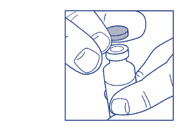
Step 2:
Wipe the rubber stopper with an alcohol swab. You do not have to shake the vial of APIDRA before use.
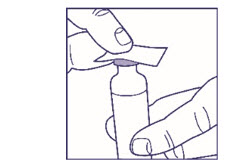
Step 3:
Draw air into the syringe equal to the insulin dose. Put the needle through the rubber top of the vial and push the plunger to inject the air into the vial.

Step 4:
Leave the syringe in the vial and turn both upside down. Hold the syringe and vial firmly in one hand. Make sure the tip of the needle is in the insulin. With your free hand, pull the plunger to withdraw the correct dose into the syringe.

Step 5:
Before you take the needle out of the vial, check the syringe for air bubbles. If you see bubbles in the syringe, hold the syringe straight up and tap the side of the syringe with your finger a few times to make any air bubbles float to the top. Gently push the air bubbles out with the plunger and draw insulin back into the syringe until you have the correct dose. If you are mixing APIDRA with NPH insulin, check with your healthcare provider on how to mix it the right way.
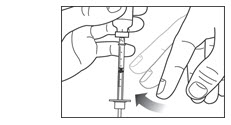
Step 6:
Remove the needle from the vial. Do not let the needle touch anything. You are now ready to inject.
Giving your APIDRA injection with a syringe
- Inject your insulin exactly as your healthcare provider has shown you.
- APIDRA starts acting fast, so give your injection within 15 minutes before or right after you eat a meal.
Step 7:
- Choose your injection site: APIDRA is injected under the skin (subcutaneously) of your upper arms, thighs, or stomach area (abdomen).
- Change (rotate) your injection sites within the area you choose for each dose to reduce your risk of getting lipodystrophy (pits in the skin or thickened skin) and localized cutaneous amyloidosis (skin with lumps) at the injection sites.
- Do not inject where the skin has pits, is thickened, or has lumps.
- Do not inject where the skin is tender, bruised, scaly or hard, or into scars or damaged skin.
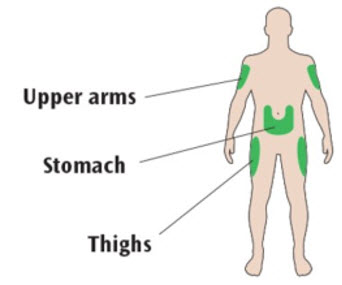
- Wipe the skin with an alcohol swab to clean the injection site. Let the injection site dry before you inject.
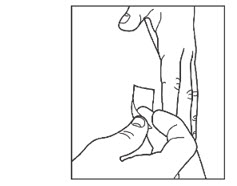
Step 8:
- Pinch the skin.
- Insert the needle in the way your healthcare provider showed you.
- Release the skin.
- Slowly push in the plunger of the syringe all the way, making sure you have injected all the insulin.
- Leave the needle in the skin for about 10 seconds.

Step 9:
- Pull the needle straight out of your skin.
- Gently press the injection site for several seconds. Do not rub the area.
- Do not recap the used needle. Recapping the needle can lead to a needle-stick injury.
Giving your APIDRA using an insulin pump
- If you have been prescribed an insulin pump, check the pump manufacturer's user manual to see if APIDRA can be used with the pump.
- APIDRA should be given into an area of your body recommended in the instructions that come with your insulin pump.
- Change (rotate) your injection sites within the area you choose for each insertion to reduce your risk of getting lipodystrophy (pits in skin or thickened skin) and localized cutaneous amyloidosis (skin with lumps) at the injection sites. Do not inject into the exact same spot for each injection. Do not inject where the skin has pits, is thickened, or has lumps. Do not inject where the skin is tender, bruised, scaly or hard, or into scars or damaged skin.
- Call your healthcare provider and choose a new infusion site if the skin at the infusion site becomes red, itchy, or thickened.
- Change the insulin in the reservoir at least every 2 days or according to the pump user manual, whichever is shorter, even if you have not used all of the insulin.
- Do not dilute or mix APIDRA with other insulins in your insulin pump.
- You should be trained on how to give insulin by injection and have an alternative insulin delivery system in case of pump failure.
- When you start using APIDRA by infusion pump, your insulin dose may need to be adjusted. Check with your healthcare provider before making any changes to your insulin dose.
- Your healthcare provider should provide recommendations for appropriate pump basal and meal-time infusion rates. Call your healthcare provider if you have any questions about using the insulin pump.
Disposing of used needles and syringes
- Put your used needles and syringes in a FDA-cleared sharps disposal container right away after use. Do not throw away (dispose of) loose needles and syringes in your household trash.
- If you do not have a FDA-cleared sharps container, you may use a household container that is:
- made of a heavy-duty plastic,
- can be closed with a tight-fitting, puncture-resistant lid, without sharps being able to come out,
- upright and stable during use,
- leak resistant, and
- properly labeled to warn of hazardous waste inside the container.
- When your sharps disposal container is almost full, you will need to follow your community guidelines for the right way to dispose of your sharps disposal container. There may be state or local laws about how you should throw away used needles and syringes. For more information about safe sharps disposal, and for specific information about sharps disposal in the state that you live in, go to the FDA's website at: http://www.fda.gov/safesharpsdisposal.
- Do not dispose of your used sharps disposal container in your household trash unless your community guidelines permit this. Do not recycle your used sharps disposal container.
How should I store APIDRA 10 mL vial?
Unopened (not in-use) APIDRA vials
- Store unused APIDRA vials in the refrigerator from 36°F to 46°F (2°C to 8°C).
- Do not freeze APIDRA.
- Keep APIDRA away from direct heat and light.
- If a vial has been frozen or overheated, throw it away.
- Unopened vials can be used until the expiration date on the carton and label if they have been stored in the refrigerator.
- Unopened vials should be thrown away after 28 days if they are stored at room temperature.
After APIDRA vials have been opened (in-use)
- Store in-use (opened) APIDRA vials in a refrigerator from 36°F to 46°F (2°C to 8°C) or at room temperature below 77°F (25°C) for up to 28 days.
- Do not freeze APIDRA.
- Keep APIDRA out of direct heat and light.
- If a vial has been frozen, throw it away.
- The APIDRA vial you are using should be thrown away after 28 days, even if it still has insulin left in it.
APIDRA in an insulin pump
- Throw away APIDRA in the pump reservoir if it has been exposed to temperatures higher than 98.6°F (37°C). This may occur if the pump housing, cover, tubing, or sport case is exposed to sunlight or direct heat.
This Instructions for Use has been approved by the U.S. Food and Drug Administration.
Revised: November 2022
Manufactured by:
sanofi-aventis U.S. LLC
Bridgewater, NJ 08807
A SANOFI COMPANYU.S. License No. 1752
©2022 sanofi-aventis U.S. LLC
-
INSTRUCTIONS FOR USE
INSTRUCTIONS FOR USE
APIDRA® SoloStar®
(insulin glulisine) injection
for subcutaneous use
3 mL single-patient-use PREFILLED PEN: (100 units/mL, U-100)Read these Instructions for Use before you start taking the APIDRA Solostar pen and each time you get a new APIDRA SoloStar pen. There may be new information. This information does not take the place of talking to your healthcare provider about your medical condition or your treatment.
Do not share your APIDRA SoloStar pen with other people, even if the needle has been changed. You may give other people a serious infection or get a serious infection from them.
People who are blind or have vision problems should not use APIDRA SoloStar prefilled pen without help from a person trained to use APIDRA SoloStar prefilled pen.
APIDRA SoloStar is a disposable prefilled pen used to inject APIDRA. Each APIDRA SoloStar has 300 units of insulin which can be used for many doses. You can select a dose from 1 to 80 units in steps of 1 unit. The pen plunger moves with each dose. The plunger will only move to the end of the cartridge when 300 units of insulin have been given.
Important information You Need to Know Before Injecting APIDRA
- Do not use your pen if it is damaged or if you are not sure that it is working properly.
- Do not use a syringe to remove insulin from your pen.
- Do not reuse needles. If you do, you might get the wrong dose of APIDRA and/or increase the chance of getting an infection.
- Always perform a safety test before each injection (see Step 3).
- Always carry a spare pen and spare needles in case they got lost or stop working.
- Change (rotate) your injection sites within the area you choose for each dose (see "Places to inject").
Learn to inject
- Talk with your healthcare provider about how to inject before using your pen.
- Ask for help if you have problems handling the pen, for example if you have problems with your sight.
- Read all of these instructions before using your pen. If you do not follow all of these instructions, you may get too much or too little insulin.
Need help?
If you have any questions about APIDRA SoloStar or about diabetes, ask your healthcare provider, go to www.apidra.com, or call sanofi-aventis U.S. at 1-800-633-1610.
Extra items you will need:
- a new sterile needle (see Step 2).
- an alcohol swab.
- a puncture-resistant container for used needles and pens. (See "Throwing your pen away".)
- Inject your insulin exactly as your healthcare provider has shown you.
- Inject your insulin under the skin (subcutaneously) of your upper legs (thighs), upper arms, or stomach area (abdomen).
- Change (rotate) your injection sites within the area you choose for each dose to reduce your risk of getting lipodystrophy (pits in skin or thickened skin) and localized cutaneous amyloidosis (skin with lumps) at the injection sites.
- Do not inject where the skin has pits, is thickened, or has lumps.
- Do not inject where the skin is tender, bruised, scaly or hard, or into scars or damaged skin.
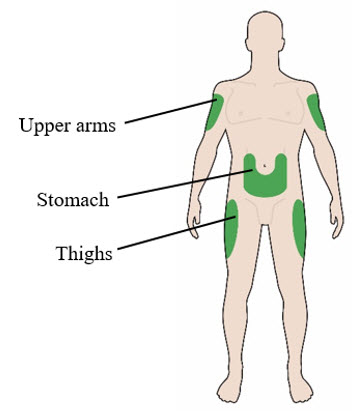
Get to know your pen

Step 1. Check your pen
Take a new pen out of the refrigerator at least 1 hour before you inject. Cold insulin is more painful to inject.
1A Check the name and expiration date on the label of your pen.
- Make sure you have the correct insulin.
- Do not use your pen after the expiration date.
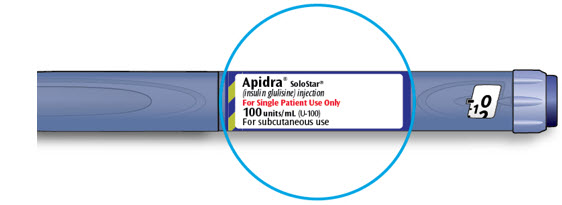
1B Pull off the pen cap.

1C Check that the insulin is clear.
- Do not use the pen if the insulin looks cloudy, colored or contains particles.
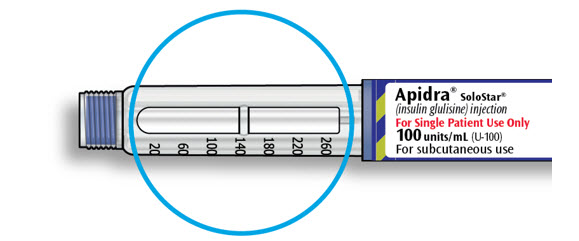
1D Wipe the rubber seal with an alcohol swab.

If you have other injector pens:
- Making sure you have the correct medicine is especially important if you have other injector pens.
- Do not reuse needles. Always use a new sterile needle for each injection. This helps stop blocked needles, contamination, and infection.
- APIDRA SoloStar may be used with pen needles from Becton Dickinson and Company, Ypsomed, and Owen Mumford. Contact your healthcare provider for further information.
2A Take a new needle and peel off the protective seal.

2B Keep the needle straight and screw it onto the pen until fixed. Do not over-tighten.

2C Pull off the outer needle cap. Keep this for later.
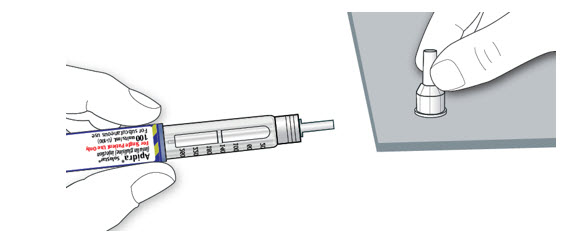
2D Pull off the inner needle cap and throw away.
Handling needles
- Take care when handling needles to prevent needle-stick injury and cross-infection.
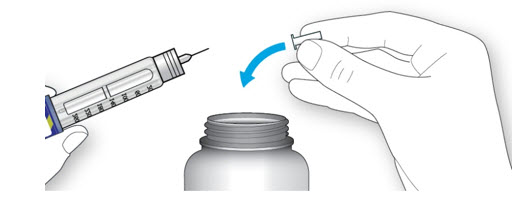
Always do a safety test before each injection to:
- Check your pen and the needle to make sure they are working properly.
- Make sure that you get the correct insulin dose.
3A Select 2 units by turning the dose selector until the dose pointer is at the 2 mark.
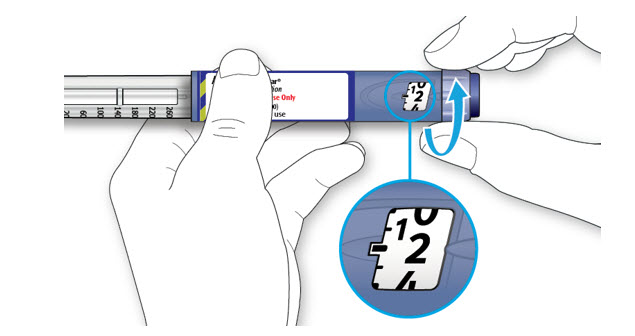
3B Press the injection button all the way in.
- When insulin comes out of the needle tip, your pen is working correctly
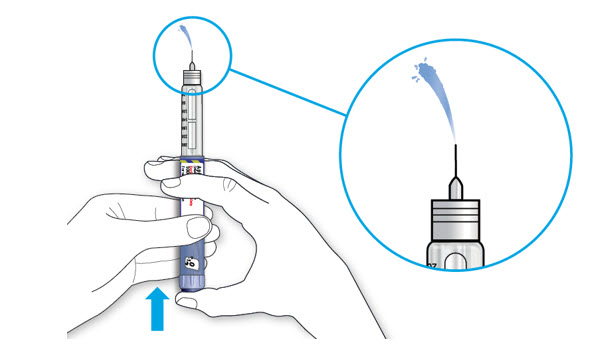
If no insulin appears:
- You may need to repeat this step up to 3 times before seeing insulin.
- If still no insulin comes out after the third time, the needle may be blocked. If this happens:
- Do not use your pen if there is still no insulin coming out of the needle tip. Use a new pen.
- Do not use a syringe to remove insulin from your pen.
If you see air bubbles:
- You may see air bubbles in the insulin. This is normal, they will not harm you.
Step 4. Select the Dose
- Do not select a dose or press the injection button without a needle attached. This may damage your pen.
4A Make sure a needle is attached and the dose is set to "0."

4B Turn the dose selector until the dose pointer lines up with your dose.
- If you turn past your dose, you can turn back down.
- If there are not enough units left in your pen for your dose, the dose selector will stop at the number of units left.
- If you cannot select your full prescribed dose, use a new pen or inject the remaining units and use a new pen to complete your dose.
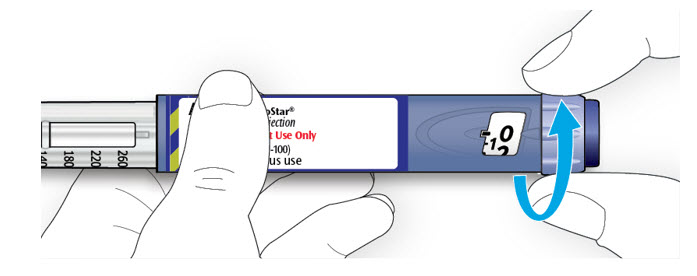
How to read the dose window
Even numbers are shown in line with dose pointer.

20 units selectedOdd numbers are shown as a line between even numbers.

21 units selectedUnits of insulin in your pen:
- Your pen contains a total of 300 units of insulin. You can select doses from 1 to 80 units in steps of 1 unit. Each pen contains more than 1 dose.
- You can see roughly how many units of insulin are left by looking at where the plunger is on the insulin scale.
Step 5. Inject your dose
If you find it hard to press the injection button in, do not force it as this may break your pen. See the section below for help.
5A Choose a place to inject as shown in the picture above (Places to inject).
5B Push the needle into your skin as shown by your healthcare provider.
Do not touch the injection button yet.
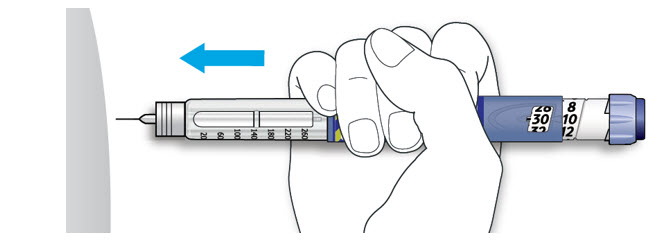
5C Place your thumb on the injection button. Then press all the way in and hold.
- Do not press at an angle. Your thumb could block the dose selector from turning.
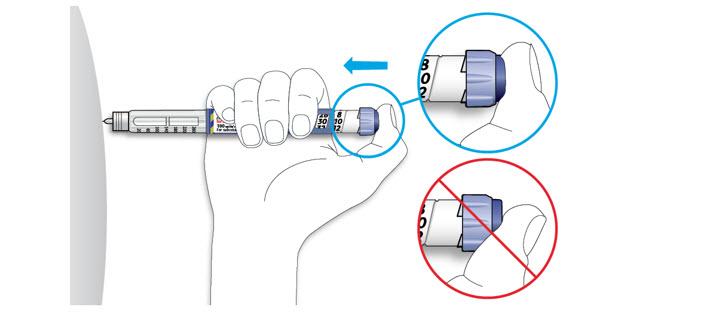
5D Keep the injection button held in and when you see "0" in the dose window, slowly count to 10.
- This will make sure you get your full dose.
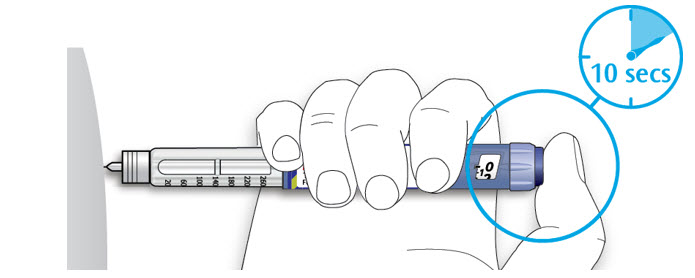
5E After holding and slowly counting to 10, release the injection button. Then remove the needle from your skin.
If you find it hard to press the button in:
- Change the needle (see Step 6 and Step 2) then do a safety test (see Step 3).
- If you still find it hard to press in, get a new pen.
- Do not use a syringe to remove insulin from your pen.
- Take care when handling needles to prevent needle-stick injury and cross-infection.
- Do not put the inner needle cap back on.
6A Grip the widest part of the outer needle cap. Keep the needle straight and guide it into the outer needle cap. Then push firmly on.
- The needle can puncture the cap if it is recapped at an angle.
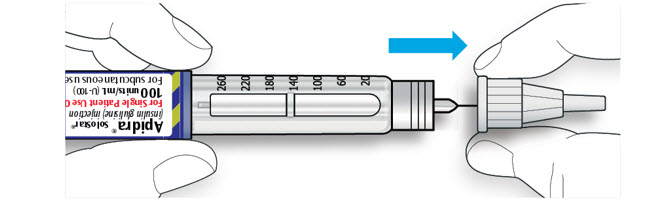
6B Grip and squeeze the widest part of the outer needle cap. Turn your pen several times with your other hand to remove the needle.
- Try again if the needle does not come off the first time.
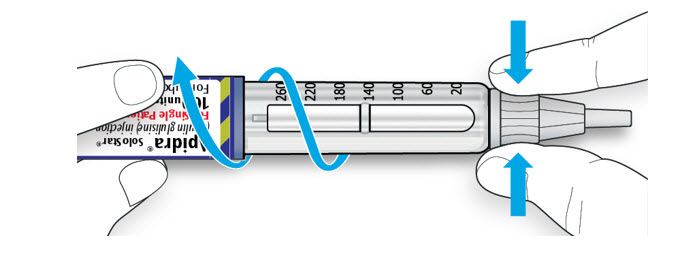
6C Throw away the used needle in a puncture-resistant container (see "Throwing your pen away" at the end of this Instructions for Use).
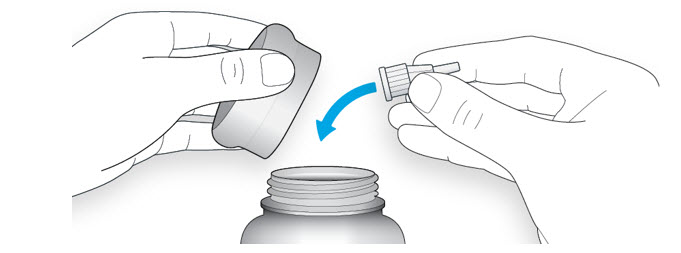
6D Put your pen cap back on.
- Do not put the pen back in the refrigerator.

How to store your pen
Before first use
- Keep new pens in the refrigerator between 36°F to 46°F (2°C to 8°C).
- Do not freeze. Do not use APIDRA if it has been frozen.
After first use
- Keep your pen at room temperature up to 77ºF (25ºC).
- Keep your pen away from heat or light.
- Store your pen with the pen cap on.
- Do not put your pen back in the refrigerator.
- Do not store your pen with the needle attached.
- Keep out of the reach of children.
- Only use your pen for up to 28 days after its first use. Throw away the APIDRA SoloStar pen you are using after 28 days, even if it still has insulin left in it.
How to care for your pen
Handle your pen with care
- Do not drop your pen or knock it against hard surfaces.
- If you think that your pen may be damaged, do not try to fix it. Use a new one.
Protect your pen from dust and dirt
- You can clean the outside of your pen by wiping it with a damp cloth (water only). Do not soak, wash or lubricate your pen. This may damage it.
- The used APIDRA SoloStar pen may be thrown away in your household trash after you have removed the needle.
- Put the used needle in a FDA-cleared sharps disposal container right away after use. Do not throw away (dispose of) loose needles and syringes in your household trash.
- If you do not have a FDA-cleared sharps disposal container, you may use a household container that is:
- made of a heavy-duty plastic,
- can be closed with a tight-fitting, puncture-resistant lid, without sharps being able to come out,
- upright and stable during use,
- leak-resistant, and
- properly labeled to warn of hazardous waste inside the container.
- When your sharps disposal container is almost full, you will need to follow your community guidelines for the right way to dispose of your sharps disposal container. There may be state or local laws about how you should throw away used needles and syringes. For more information about safe sharps disposal, and for specific information about sharps disposal in the state that you live in, go to the FDA's website at: https://fda.gov/safesharpsdisposal.
- Do not dispose of your used sharps disposal container in your household trash unless your community guidelines permit this. Do not recycle your used sharps disposal container.
This Instructions for Use has been approved by the U.S. Food and Drug Administration.
Revised: November 2022
Manufactured by:
sanofi-aventis U.S. LLC
Bridgewater, NJ 08807
A SANOFI COMPANY
U.S. License No. 1752©2022 sanofi-aventis U.S. LLC
- PRINCIPAL DISPLAY PANEL - 10 mL Vial Carton
-
PRINCIPAL DISPLAY PANEL - 3 mL Pen Carton
NDC 0088-2502-05
Rx onlyApidra® SoloStar®
(insulin glulisine) injectionFor Single Patient Use Only
100 units/mL (U-100)
For subcutaneous useFive 3 mL Prefilled Pens – Dispense in this sealed carton
Solution for injection in a disposable insulin delivery device
Use only if solution is clear and colorless with no particles visible
Use within 28 days after initial use
*Needles not included (see back panel)sanofi
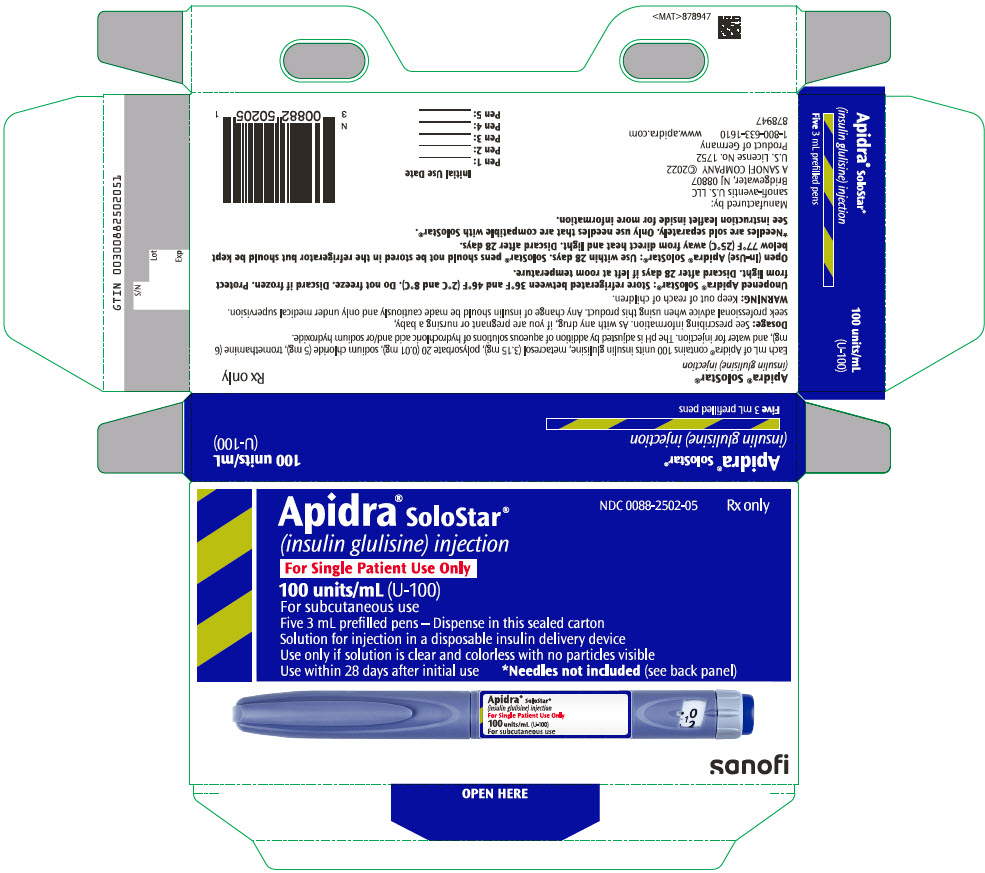
-
INGREDIENTS AND APPEARANCE
APIDRA
insulin glulisine injection, solutionProduct Information Product Type HUMAN PRESCRIPTION DRUG Item Code (Source) NDC:0088-2500 Route of Administration SUBCUTANEOUS, INTRAVENOUS Active Ingredient/Active Moiety Ingredient Name Basis of Strength Strength INSULIN GLULISINE (UNII: 7XIY785AZD) (INSULIN GLULISINE - UNII:7XIY785AZD) INSULIN GLULISINE 100 [iU] in 1 mL Inactive Ingredients Ingredient Name Strength METACRESOL (UNII: GGO4Y809LO) 3.15 mg in 1 mL TROMETHAMINE (UNII: 023C2WHX2V) 6 mg in 1 mL SODIUM CHLORIDE (UNII: 451W47IQ8X) 5 mg in 1 mL POLYSORBATE 20 (UNII: 7T1F30V5YH) 0.01 mg in 1 mL WATER (UNII: 059QF0KO0R) HYDROCHLORIC ACID (UNII: QTT17582CB) SODIUM HYDROXIDE (UNII: 55X04QC32I) Packaging # Item Code Package Description Marketing Start Date Marketing End Date 1 NDC:0088-2500-33 1 in 1 CARTON 02/24/2009 1 10 mL in 1 VIAL, GLASS; Type 0: Not a Combination Product 2 NDC:0088-2500-34 1 in 1 CARTON 02/24/2009 2 10 mL in 1 VIAL, GLASS; Type 0: Not a Combination Product Marketing Information Marketing Category Application Number or Monograph Citation Marketing Start Date Marketing End Date BLA BLA021629 02/24/2009 APIDRA SOLOSTAR
insulin glulisine injection, solutionProduct Information Product Type HUMAN PRESCRIPTION DRUG Item Code (Source) NDC:0088-2502 Route of Administration SUBCUTANEOUS Active Ingredient/Active Moiety Ingredient Name Basis of Strength Strength INSULIN GLULISINE (UNII: 7XIY785AZD) (INSULIN GLULISINE - UNII:7XIY785AZD) INSULIN GLULISINE 100 [iU] in 1 mL Inactive Ingredients Ingredient Name Strength METACRESOL (UNII: GGO4Y809LO) 3.15 mg in 1 mL TROMETHAMINE (UNII: 023C2WHX2V) 6 mg in 1 mL SODIUM CHLORIDE (UNII: 451W47IQ8X) 5 mg in 1 mL POLYSORBATE 20 (UNII: 7T1F30V5YH) 0.01 mg in 1 mL WATER (UNII: 059QF0KO0R) HYDROCHLORIC ACID (UNII: QTT17582CB) SODIUM HYDROXIDE (UNII: 55X04QC32I) Packaging # Item Code Package Description Marketing Start Date Marketing End Date 1 NDC:0088-2502-05 5 in 1 CARTON 02/24/2009 1 NDC:0088-2502-00 3 mL in 1 SYRINGE, PLASTIC; Type 3: Prefilled Biologic Delivery Device/System (syringe, patch, etc.) 2 NDC:0088-2502-01 1 in 1 CARTON 02/24/2009 2 3 mL in 1 SYRINGE, PLASTIC; Type 3: Prefilled Biologic Delivery Device/System (syringe, patch, etc.) Marketing Information Marketing Category Application Number or Monograph Citation Marketing Start Date Marketing End Date BLA BLA021629 02/24/2009 Labeler - sanofi-aventis U.S. LLC (783243835) Establishment Name Address ID/FEI Business Operations Sanofi-Aventis Deutschland GmbH 313218430 ANALYSIS(0088-2500, 0088-2502) , MANUFACTURE(0088-2500, 0088-2502) , API MANUFACTURE(0088-2500, 0088-2502) , PACK(0088-2500, 0088-2502) , LABEL(0088-2500, 0088-2502)



